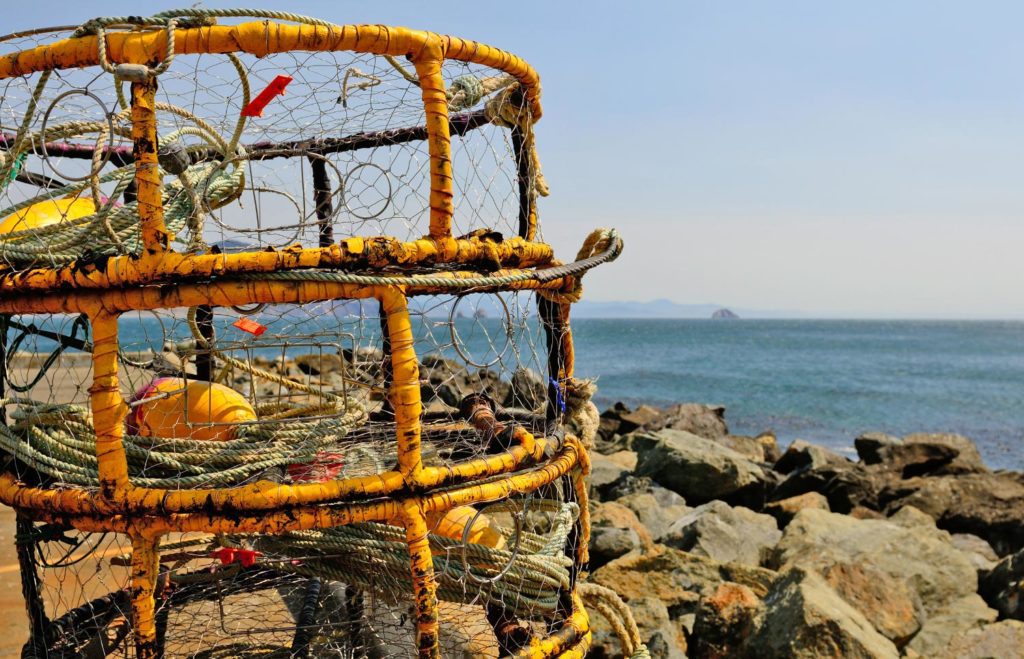Sea Otter & Fisheries
Review the Potential Impact of Sea Otters on Fisheries in Oregon
Facts and Frequently Asked Questions
The simple question often asked “will sea otters affect fisheries when they return to Oregon?” has an answer that is both straightforward and complex.
The short answer is that none of Oregon’s marine fisheries will be adversely affected. Sea otters do not prey on finfish such as salmon, rockfish, halibut, or tuna, the far largest share of ocean commercial fisheries in Oregon. Two commercial ocean shellfisheries for Dungeness crab and red sea urchins may be affected in a few nearshore places.
Overall, sea otters are likely to benefit marine fisheries by helping restore and protect the kelp forests and eelgrass beds that are crucial habitat in the life-cycle of many fish species. Reintroducing sea otters will help increase the diversity, productivity, and resilience of the marine and estuarine ecosystems that all fisheries require.
Unlike Southeast Alaska, Oregon’s coast does not have the habitat required to support many thousands of animals along the entire coast that are envisioned by some, especially opponents of reintroduction. It will take decades for the population of sea otters to increase from several dozen to even a thousand and to reach all potential habitat areas.
- Fact One
Sea otters do not hunt or eat finfish, except in rare instances.
For sea otters, finfish such as salmon and rockfish are difficult to chase and capture. To meet their high energy demands, sea otters instead target calorie-rich shellfish that are easier to catch. Only rarely have sea otters been observed eating an unlucky finfish, usually a sole or other species that lie still, hiding on the ocean floor.
- Fact Two
Sea otters and commercial crabbing occupy different depths.
Sea otters tend to stay in shallow water over rocky bottom areas close to shore where their prey live and they don’t have to dive far to find food. Nearly all of Oregon’s commercial Dungeness crab harvest takes place on sandy or muddy bottoms in deeper waters offshore. Sea otters may feed in some shallow-water areas where red sea urchin and Dungeness crab are harvested. The Elakha Alliance is working with local fishermen to understand the potential overlap and possible impacts of sea otters on shellfish in these areas and to develop ways to avoid or mitigate effects.
- Fact Three
Sea otters do not migrate. They stay put.
Unlike sea lions, whales, and other marine mammals, sea otters do not migrate, although a few adolescent males are known to explore new areas. As long as food is available, sea otters, especially females, will stay in their home area to save energy while nursing and feeding her pup. Thus, areas occupied by sea otters will expand slowly only as increasing numbers females seek new food sources. Oregon’s sea otter population will likely be small, confined to localized habitat areas for many decades.
- Fact Four
Oregon is not Alaska.
Tales from Southeast Alaska of thousands of sea otters depleting Dungeness crab and other shellfisheries are often cited to predict the same for the Oregon coast. However, there are significant differences between Oregon’s linear coast with limited habitat areas and Southeast Alaska with almost unlimited habitat in a complex, diverse geography of islands, coves, rocks, fjords, and inlets. As a result, the availability of such diverse habitat enables large, dense populations of sea otters in the same areas where commercial crabbing and other shellfisheries occur. As explained in Fact Two, above, Oregon’s commercial crabbing takes place offshore in deeper water than preferred shallow-water near shore sea otter habitat. And as explained in Fact Five, below, Oregon will never have the high population numbers as in SE Alaska. These differences mean that the tales from SE Alaska are highly unlikely to occur in Oregon.
- Fact Five
There will be relatively few sea otters in Oregon.
An initial release of sea otters will likely involve fewer than one hundred animals, at a few carefully chosen locations. Computer simulations, based on scientific studies, predict an establishment period after release during which the number of sea otters will decline over the first few years before the population stabilizes and begins to increase. Because sea otter females produce only one pup a year, population models show that twenty-five to thirty years will be required for the population to return to the initial number of animals introduced. Then, many more decades will be required for the population to expand to larger numbers and more locations, but current modeling suggests that the Oregon Coast will be able to sustain fewer than 4,000 along the 360-mile coastline.

Frequently Asked Questions:
Answer: No
Sea otters do not hunt or prey upon finfish such as rockfish, salmon, ling cod, halibut, tuna, and other species that comprise important commercial fisheries on the Oregon Coast. Sea otters prefer shallow water habitats and many of these fisheries take place in waters too deep for sea otters to dive. Midwater fisheries for whiting, market squid, pink shrimp and spot prawns won’t be affected by sea otter reintroduction for the same reasons.
Answer: No
Sea otters almost certainly will have no noticeable effect on Oregon’s commercial Dungeness crab Sea Otter -Fisheries FAQ p.2 fishery. The number of sea otters will be small for decades and will occupy habitats in shallow water closer to shore whereas nearly all commercial crabbing is pursued in much deeper waters over vast areas offshore. Studies in California (Boustany-et al 2021, Grimes et al 2020) show that sea otters have had no impact on commercial Dungeness crab harvests. On the Washington coast there has been no discernible impact on commercial crabbing from sea otters. However, in some localized shallow “beach” crabbing areas, sea otters may compete for adult crabs with impacts anticipated to be minor.
Answer: Highly likely – in some areas.
There is only one, very small, ocean commercial dive fishery in Oregon for red sea urchins on the Southern Oregon Coast. If studies lead to sea otters being released in that region, the red urchin fishery will likely be impacted. At present, however, the fishery for red urchins is greatly limited by the spread of purple urchin that have decimated kelp forests, their primary food source. A commercial dive fishery for clams in Tillamook Bay, several hundred miles from possible release areas, is unlikely to be affected.
Answer: No
They will benefit those fisheries. Sea otters will not harm recreational fisheries for salmon, rockfish, ling cod and other species for the reasons stated in Answer 1. They will benefit recreational fisheries by helping restore and protect the kelp forests and eelgrass beds that are crucial habitat in the life-cycle of nearly all these fish species. In addition, the presence of sea otters is highly likely to draw visitors, enlarging the client base for charter boat recreational fisheries.
Answer: Perhaps, in a few places
Recreational crabbing and clamming are popular in many estuaries. If sea otters are in the adjacent ocean, some may enter the bay and may then prey on crabs or clams of recreational interest and, depending on the number of animals, affect those fisheries. However, the number of sea otters in any estuary will be small while the crab population will be large. Also, they will likely prey on invasive European green crabs that are now degrading estuarine habitat and, by digging in the mud for small clams, will promote the growth of eelgrass, an important habitat for juvenile Dungeness crab.
Answer: No
Unlike sea lions, sea otters are unlikely to frequent local ports or other areas of high human activity and are not likely habituate to human activities and haul out on docks or otherwise interfere with port operations. If animals do take up residence in an estuary, it will be a few individuals, unlike the large numbers of pinnipeds that congregate on local docks.
Answer: It depends
There are no data to show that sea otters prey on commercially grown oysters. Commercial oysters cultivated in Coos Bay, Tillamook Bay, Yaquina Bay, and Netarts Bay are typically grown on muddy Sea Otter -Fisheries FAQ p. 3 substrate where they could be vulnerable to predation from any sea otters that might discover those beds. However, in SE Alaska where many sea otters are present, oysters are successfully grown on racks in protective nets or cages. It is unknown whether the presence of commercial oyster production could attract sea otters into an estuary. That does not seem to be the case in Washington where a large sea otter population is present just north of major oyster growing estuaries.
Answer: No
Two federal lease areas for offshore wind development are located off Oregon; one is 32 miles west of Florence and the other is 18 miles west of Brookings. Both are west of the edge of the continental shelf in water between 600 and 2000 feet deep, far too deep for either sea otters or their prey.
Resources:
See relevant chapters in the Elakha Alliance Feasibility Study:
- Chapter 3: Population and Demographic Considerations
- Chapter 5: Ecosystem Effects of Sea Otters
- Chapter 6: Habitat Suitability
- Chapter 7: Socioeconomic Considerations
- Chapter 9: Implementation and Logistics’
- Chapter 11: Stakeholder Concerns and Perspectives
- Appendix: Oregon Sea Otter Reintroduction Model and User Interface

